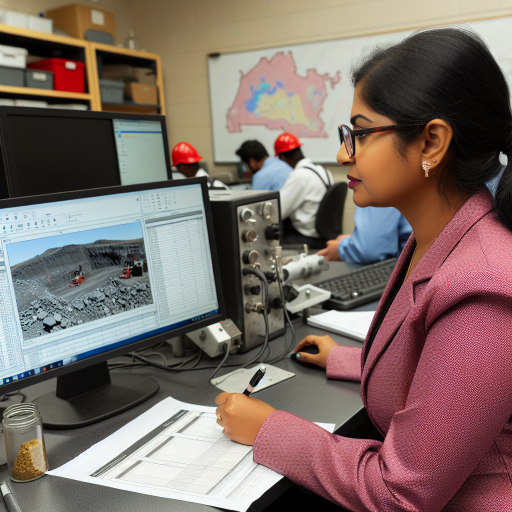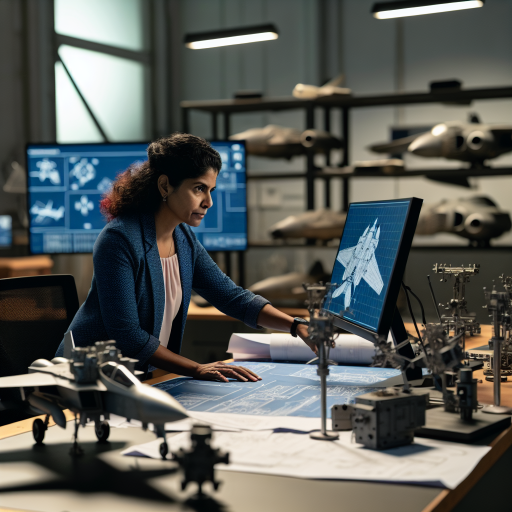Fundamental Knowledge in Mathematics and Physics
Importance of Mathematics
Mathematics is the backbone of aerospace engineering.
Engineers utilize mathematical models to predict outcomes.
They apply calculus for understanding changing systems.
Additionally, algebra helps in solving complex equations.
Geometry is crucial for analyzing shapes and dimensions.
Trigonometry assists engineers in understanding angles.
Overall, advanced math skills are essential in this field.
Role of Physics in Aerospace Engineering
Physics principles govern the behavior of aircraft and spacecraft.
Engineers must understand forces such as lift and drag.
They analyze motion through Newton’s laws of motion.
Thermodynamics is important for understanding propulsion systems.
Fluid dynamics facilitates the study of air pressure changes.
Furthermore, electromagnetism plays a role in avionics.
Physics provides the foundational knowledge needed for design and analysis.
Interconnection of Math and Physics
Mathematics and physics work hand-in-hand in aerospace engineering.
Engineers use math to quantify physical phenomena.
For example, they apply equations of motion to predict flight paths.
Moreover, mathematical modeling helps optimize design parameters.
Visualization techniques often translate physical concepts into mathematical models.
Consequently, mastery of both subjects is vital for success.
Proficiency in Engineering Software and Tools
Importance of Software Proficiency
Success in aerospace engineering requires strong software skills.
Engineers rely on various tools to facilitate design and testing.
Fluency in software can enhance productivity and innovation.
Moreover, it allows for accurate simulations and analyses.
Commonly Used Software in Aerospace Engineering
- ANSYS for computational fluid dynamics and structural analysis.
- MATLAB for advanced calculations and data visualization.
- CATIA for 3D modeling and product lifecycle management.
- SolidWorks for detailed CAD designs and simulations.
- Autodesk for aerospace design applications and rendering.
Key Skills to Develop
Engineers should focus on mastering critical software tools.
Unlock Your Career Potential
Visualize a clear path to success with our tailored Career Consulting service. Personalized insights in just 1-3 days.
Get StartedUnderstanding coding languages like Python enhances automation.
Furthermore, knowledge of data analysis is increasingly important.
Additionally, simulation skills help predict real-world performance.
Staying Updated with Technological Advancements
The aerospace industry constantly evolves with new technologies.
Engineers must keep their software skills current and relevant.
Attending workshops and training sessions is advisable.
Joining professional organizations can also provide valuable resources.
Ultimately, staying abreast of industry trends will foster career growth.
Strong Problem-Solving and Analytical Skills
Importance of Problem Solving
Problem-solving lies at the heart of aerospace engineering.
Engineers must tackle complex challenges daily.
These challenges often arise during design, testing, and production.
A strong grasp of problem-solving principles is essential.
Furthermore, engineers must think critically to develop innovative solutions.
Analytical Skills in Practice
Analytical skills are equally crucial in aerospace engineering.
Engineers analyze vast amounts of data from various sources.
This data helps them make informed decisions effectively.
For instance, flight performance and safety data are critical.
Moreover, engineers assess risks and potential failures systematically.
Applying Skills to Real-World Scenarios
Real-world applications require both problem-solving and analytical skills.
Engineers often collaborate on projects under tight deadlines.
In these situations, they must quickly identify problems.
They also need to propose feasible solutions promptly.
Effective communication enhances collaborative efforts in teams.
Developing These Skills
Individuals aspiring to work in aerospace engineering should hone these skills.
Engaging in hands-on projects fosters practical problem-solving abilities.
Additionally, participating in team-based activities enhances collaboration.
Courses in mathematics and physics strengthen analytical thinking.
Ultimately, continuous learning is vital for growth in this field.
Discover More: Metallurgical Engineering Salary Insights in Canada
Effective Communication and Teamwork Abilities
Importance of Communication in Aerospace Engineering
Effective communication is foundational in aerospace engineering.
It facilitates collaboration among diverse team members.
Engineers must clearly convey complex technical concepts.
Additionally, they share project updates to keep everyone informed.
This reduces misunderstandings and enhances project efficiency.
Building Strong Team Dynamics
Aerospace projects often require various skills and expertise.
Teamwork enhances problem-solving abilities in complex challenges.
Each member brings unique perspectives that drive innovation.
Successful teams foster a culture of respect and support.
Role of Active Listening
Active listening is a crucial component of effective communication.
This ensures that all team members feel valued and understood.
Engineers should ask clarifying questions when necessary.
This practice avoids assumptions and promotes clearer discussions.
Utilizing Collaborative Tools
Technology plays a vital role in facilitating teamwork.
Collaboration tools help teams coordinate tasks and share information.
Platforms like Slack or Microsoft Teams enhance communication flow.
Document-sharing services streamline access to important files.
Engaging in Team-Building Activities
Participating in team-building exercises strengthens relationships.
These activities improve trust and collaboration among team members.
They also encourage open dialogue and creative thinking.
Regular engagement helps maintain a positive team spirit.
See Related Content: Biomedical Engineer Roles in the Healthcare Industry
Understanding Aerospace Materials and Manufacturing Processes
Introduction to Aerospace Materials
Aerospace materials play a critical role in the performance of aircraft and spacecraft.
These materials must be lightweight yet strong to withstand extreme conditions.
Commonly used materials include aluminum alloys, titanium, and composite materials.
Each material offers unique properties that engineers must understand.
For instance, aluminum is widely used due to its low density and strength.
On the other hand, titanium provides excellent fatigue resistance and high strength-to-weight ratio.
Composite materials are becoming increasingly popular due to their versatility.
Importance of Manufacturing Processes
The manufacturing processes used in aerospace engineering are as important as the materials themselves.
Precision manufacturing ensures safety and performance standards are met.
Common processes include machining, welding, and additive manufacturing.
These techniques require skilled engineers familiar with their intricacies.
For example, machining involves shaping materials using cutting tools with high precision.
Welding connects materials through heat, requiring knowledge of thermal properties.
Additive manufacturing enables the creation of complex shapes that traditional methods cannot achieve.
Understanding Material Properties
Engineers must comprehend the properties of different aerospace materials.
Properties like tensile strength and fatigue resistance are crucial in material selection.
Additionally, understanding thermal properties helps predict material behavior under stress.
Corrosion resistance is another vital factor, especially for components exposed to harsh environments.
Ultimately, the right material must be chosen based on the specific requirements of each application.
Advancements in Materials Science
Research in materials science continuously evolves, leading to innovative materials.
For instance, the development of lightweight alloys enhances fuel efficiency.
Nanomaterials are an exciting area of focus, promising improved properties.
Engineers should stay updated on advancements to maintain a competitive edge.
Collaboration with researchers can yield new materials tailored for aerospace applications.
Software and Simulation Tools
Understanding software for material analysis is crucial for modern aerospace engineering.
Simulation tools help engineers predict how materials will behave in real-world scenarios.
These tools assist in optimizing designs before production begins.
Additionally, learning these tools can enhance an engineer’s productivity.
Familiarity with software like ANSYS and SolidWorks is advantageous.
Continuous Learning and Adaptation
The aerospace industry is dynamic, and skills must continually evolve.
Engineers should participate in ongoing education programs and workshops.
Networking with professionals can provide insights into emerging trends.
Moreover, hands-on experience complements theoretical knowledge.
Embracing a mindset of lifelong learning is essential for success in aerospace engineering.
Discover More: Top Universities for Aerospace Engineering Studies

Familiarity with Aerospace Regulations and Standards
Importance of Regulations
Aerospace regulations ensure safety in aviation operations.
They protect passengers, crew, and cargo alike.
Additionally, compliance prevents costly legal issues.
Professionals must understand these regulations thoroughly.
Key Regulatory Bodies
The Federal Aviation Administration (FAA) governs aviation in the United States.
The European Union Aviation Safety Agency (EASA) oversees aviation matters in Europe.
Each entity establishes essential guidelines and standards.
Professionals should stay updated on changes from these organizations.
Understanding Standards
Beyond regulations, industry standards play a crucial role.
Organizations like the American National Standards Institute (ANSI) provide guidance.
Standards help set benchmarks for safety and performance.
Familiarity with these standards is essential for engineering success.
Staying Informed
Attending workshops and conferences enhances understanding of regulations.
Networking with industry professionals offers valuable insights.
Moreover, joining relevant associations can be beneficial.
Continued education remains vital in this ever-evolving field.
You Might Also Like: Professional Associations for Metallurgical Engineers
Project Management and Organizational Skills
Importance of Project Management
Project management is crucial in aerospace engineering.
It ensures timely completion of complex projects.
Additionally, it aids in resource allocation and scheduling.
Effective project management enhances teamwork and collaboration.
Key Project Management Skills
Aerospace engineers must possess various project management skills.
Firstly, time management helps to meet deadlines efficiently.
Secondly, budgeting skills allow for effective cost control.
Moreover, risk management helps anticipate potential project challenges.
Lastly, communication skills foster clear dialogue among team members.
Organizational Skills Overview
Strong organizational skills are vital for aerospace engineers.
These skills help manage multiple tasks and projects simultaneously.
A well-organized engineer remains focused and productive.
Developing Organizational Skills
Engineers can improve their organizational skills through practice.
Creating checklists and schedules enhances prioritization abilities.
Additionally, using project management software helps track progress.
Regularly reviewing goals can also improve personal organization.
Collaborative Management Techniques
Collaboration is key in aerospace engineering projects.
Utilizing teamwork encourages diverse input and innovation.
Furthermore, conducting regular meetings ensures everyone is aligned.
This collective approach drives project success and efficiency.
Continuous Learning and Adaptability to New Technologies
The Importance of Continuous Learning
Aerospace engineering continuously evolves due to technological advancements.
Engineers must stay updated on the latest innovations.
Continuous learning helps professionals adapt to changes in the industry.
This growth fosters improved skills and knowledge.
Options for Continuous Learning
A variety of resources are available for learning.
Online courses offer flexible scheduling for busy professionals.
Webinars provide access to experts across the globe.
Professional organizations often host workshops and conferences.
Networking with peers facilitates knowledge sharing and collaboration.
Adaptability to New Technologies
Adaptability is critical in a fast-paced environment.
Engineers must embrace new tools and methodologies.
For instance, simulation software plays a vital role in design processes.
Additionally, advancements in materials science revolutionize aerospace manufacturing.
Staying Ahead of Industry Trends
Being proactive allows engineers to anticipate changes.
Following industry news informs about emerging technologies.
Regularly reading aerospace journals enhances technical knowledge.
Participation in forums and discussion groups encourages insight from others.
Long-Term Success in Aerospace Engineering
Continuous learning and adaptability ensure long-term success in aerospace engineering.
By actively engaging in education, professionals can maintain their competitiveness.
Ultimately, these skills will drive innovations in the aerospace field.
Additional Resources
Types of Engineering: What Are They? Everything Explained | NU




